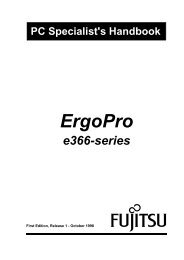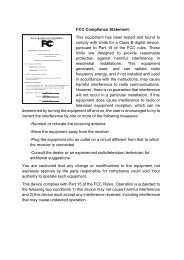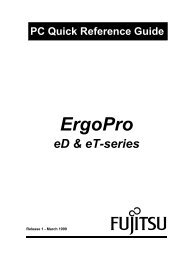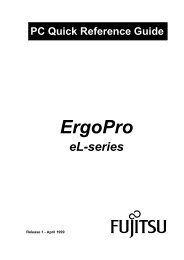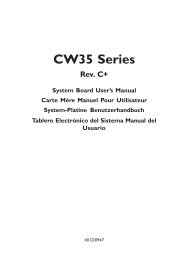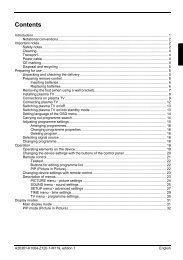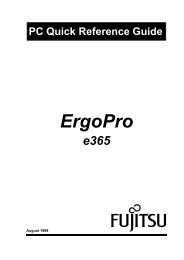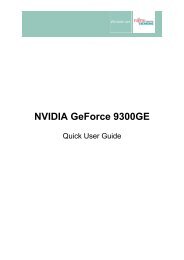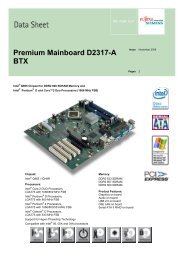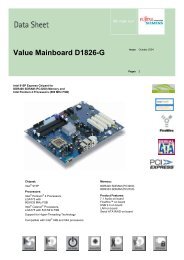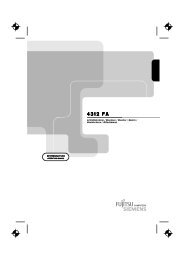Create successful ePaper yourself
Turn your PDF publications into a flip-book with our unique Google optimized e-Paper software.
answers<br />
2<br />
Technical Manual<br />
<strong>Mainboard</strong> <strong>D1596</strong><br />
English
Are there ...<br />
... any technical problems or other questions you need clarified?<br />
Please contact:<br />
• your sales partner<br />
• your sales outlet<br />
The latest information and updates (e. g. BIOS update) on our mainboards can be found on the<br />
Internet under: http://www.fujitsu-siemens.com
Dieses Handbuch wurde auf Recycling-Papier gedruckt.<br />
This manual has been printed on recycled paper.<br />
Ce manuel est imprimé sur du papier recyclé.<br />
Este manual ha sido impreso sobre papel reciclado.<br />
Questo manuale è stato stampato su carta da riciclaggio.<br />
Denna handbok är tryckt på recyclingpapper.<br />
Dit handboek werd op recycling-papier gedrukt.<br />
Herausgegeben von/Published by<br />
<strong>Fujitsu</strong> Siemens Computers GmbH<br />
Bestell-Nr./Order No.: A26361-<strong>D1596</strong>-Z120-2-7619<br />
Printed in the Federal Republic of Germany<br />
AG 0103 01/03
<strong>Mainboard</strong> <strong>D1596</strong><br />
Technical Manual<br />
January 2003 edition<br />
English
Microsoft, MS, MS-DOS and Windows are registered trademarks of Microsoft Corporation.<br />
PS/2 and OS/2 Warp are registered trademarks of International Business Machines, Inc.<br />
All other trademarks referenced are trademarks or registered trademarks of their respective<br />
owners, whose protected rights are acknowledged.<br />
All rights, including rights of translation, reproduction by printing, copying or similar methods,<br />
even of parts are reserved.<br />
Offenders will be liable for damages.<br />
All rights, including rights created by patent grant or registration of a utility model or design,<br />
are reserved. Delivery subject to availability.<br />
Right of technical modification reserved.<br />
This manual was produced by<br />
cognitas. Gesellschaft für Technik-Dokumentation mbH<br />
www.cognitas.de
Overview <strong>Mainboard</strong> <strong>D1596</strong><br />
Internal connectors and slots<br />
12<br />
11<br />
10<br />
9<br />
8<br />
Socket A<br />
PCI 1<br />
PCI 2<br />
PCI 3<br />
External connectors<br />
LAN<br />
AGP<br />
1314 15 16<br />
BIOS<br />
Battery<br />
7<br />
Onboard LAN is optional<br />
DDR 1<br />
6<br />
DDR 2<br />
Buzzer<br />
AUDIO<br />
A26361-<strong>D1596</strong>-Z120-2-7619 Umschlag/Cover<br />
1<br />
2<br />
3<br />
4<br />
5<br />
1 = Power Supply (ATX)<br />
2 = Floppy disk drive<br />
3 = Primary IDE<br />
4 = Secondary IDE<br />
5 = Front panel<br />
6 = F_USB2<br />
7 = F_USB1<br />
8 = IR<br />
9 = CD_IN<br />
10 = AUX_IN<br />
11 = F_AUDIO<br />
12 = COMB<br />
13 = CPU_FAN<br />
14 = SYS_FAN<br />
15 = RAM_LED<br />
16 = CLK_JP (Jumper)<br />
Front panel<br />
Power On LED<br />
Speaker<br />
Power On/Off<br />
+<br />
+<br />
HD-LED<br />
Reset<br />
+<br />
Sleep LED
Contents<br />
Overview <strong>Mainboard</strong> <strong>D1596</strong> ............................................................................................................1<br />
<strong>Mainboard</strong> <strong>D1596</strong>.............................................................................................................................1<br />
Notational conventions ..............................................................................................................1<br />
Important notes .................................................................................................................................2<br />
Information about mainboards ...................................................................................................2<br />
List of features...................................................................................................................................3<br />
Interfaces and connectors ..............................................................................................................4<br />
External ports ....................................................................................................................................4<br />
Internal ports and connectors ............................................................................................................5<br />
Hard disk connection .................................................................................................................5<br />
Pin assignment of internal ports ........................................................................................................6<br />
Settings with jumpers .....................................................................................................................9<br />
CPU Speed Setup .............................................................................................................................9<br />
Add-on modules / Upgrading .......................................................................................................10<br />
Installing and removing processors .................................................................................................10<br />
Installing the processor with heat sink and fan.........................................................................10<br />
Upgrading main memory..........................................................................................................12<br />
Upgrading AGP screen controllers ..................................................................................................14<br />
Adding PCI cards ............................................................................................................................15<br />
PCI bus interrupts - Selecting correct PCI slot.........................................................................15<br />
Replacing lithium battery .........................................................................................................16<br />
BIOS Setup.....................................................................................................................................17<br />
Entering Setup.................................................................................................................................17<br />
Getting Help ....................................................................................................................................18<br />
The Main Menu (For example: BIOS Ver. : F1h)..............................................................................18<br />
Standard CMOS Features ...............................................................................................................20<br />
BIOS Features Setup ......................................................................................................................23<br />
Chipset Features Setup...................................................................................................................25<br />
Power Management Setup ..............................................................................................................28<br />
PNP/PCI Configuration....................................................................................................................31<br />
Load Fail-Safe Defaults ...................................................................................................................33<br />
Load Optimized Defaults .................................................................................................................34<br />
Integrated Peripherals .....................................................................................................................35<br />
Hardware Monitor & MISC Setup.....................................................................................................39<br />
Set Supervisor / User Password......................................................................................................40<br />
IDE HDD Auto Detection .................................................................................................................41<br />
Save & Exit Setup ...........................................................................................................................42<br />
Exit Without Saving .........................................................................................................................43<br />
BIOS update....................................................................................................................................44<br />
Glossary.........................................................................................................................................45<br />
A26361-<strong>D1596</strong>-Z120-2-7619
<strong>Mainboard</strong> <strong>D1596</strong><br />
Your mainboard is available in different configuration levels. Depending on the configuration chosen,<br />
some of the hardware components described may not be available on your mainboard.<br />
Further information<br />
Information and additional descriptions of the drivers are contained:<br />
• in the readme files on your hard disk<br />
• on the driver floppy disks included<br />
• on the CD "Drivers & Utilities Collection" or "Drivers & Utilities" or "ServerStart".<br />
i<br />
The programme Acrobat Reader must be installed to be able to open the manuals. You<br />
may find the programme on the CD-ROM directory: utls/acrobat.<br />
For more details please read the according readme.txt files.<br />
Notational conventions<br />
The meanings of the symbols and fonts used in this manual are as follows:<br />
indicates information which is important for your health or for preventing physical<br />
damage.<br />
!<br />
i indicates additional information which is required to use the system properly.<br />
Ê Text which follows this symbol describes activities that must be performed in the order shown.<br />
Ë This symbol indicates that you must enter a blank space (press the Space Bar) at this point.<br />
Ú This symbol indicates that you must press the Enter key.<br />
Text in this typeface indicates screen outputs.<br />
Text in this bold typeface indicates the entries you make via the keyboard.<br />
Text in italics indicates commands or menu items.<br />
"Quotation marks" indicate names of chapters or terms.<br />
A26361-<strong>D1596</strong>-Z120-2-7619 English - 1
<strong>Mainboard</strong> <strong>D1596</strong><br />
Important notes<br />
With the mainboard installed you must open the system to access the mainboard. How to dismantle<br />
and reassemble the system is described in the operating manual accompanying the system.<br />
Connecting cables for peripherals must be adequately shielded to avoid interference.<br />
Observe the safety notes in the operating manual of your system.<br />
! Incorrect replacement of the lithium battery may lead to a risk of explosion. It is therefore<br />
essential to observe the instructions in the "Add-on modules / Upgrading" - "Replacing<br />
lithium battery" section.<br />
Components can become very hot during operation. Ensure you do not touch<br />
components when making extensions to the mainboard. There is a danger of burns!<br />
i<br />
The shipped version of this board complies with the requirements of the EEC directive<br />
89/336/EEC "Electromagnetic compatibility".<br />
Compliance was tested in a typical PC configuration.<br />
The warranty is invalidated if the system is damaged during the installation or<br />
replacement of expansions. Information on which expansions you can use is available<br />
from your sales outlet or the customer service centre.<br />
Information about mainboards<br />
To prevent damage to the mainboard, the components and conductors on it, please take great care<br />
when you insert or remove boards. Take great care to ensure that extension boards are slotted in<br />
straight, without damaging components or conductors on the mainboard, or any other components,<br />
for example EMI spring contacts.<br />
Remove the plug from the mains outlet so that system and mainboard are totally disconnected from<br />
the mains voltage.<br />
Be careful with the locking mechanisms (catches, centring pins etc.) when you replace the<br />
mainboard or components on it, for example memory modules or processors.<br />
Never use sharp objects (screwdrivers) for leverage.<br />
Boards with electrostatic sensitive devices (ESD) are identifiable by the label shown.<br />
When you handle boards fitted with ESDs, you must, under all circumstances,<br />
observe the following:<br />
• You must always discharge static build up (e.g. by touching a grounded object)<br />
before working.<br />
• The equipment and tools you use must be free of static charges.<br />
• Remove the power plug from the mains supply before inserting or removing<br />
boards containing ESDs.<br />
• Always hold boards with ESDs by their edges.<br />
• Never touch pins or conductors on boards fitted with ESDs.<br />
2 - English A26361-<strong>D1596</strong>-Z120-2-7619
List of features<br />
<strong>Mainboard</strong> <strong>D1596</strong><br />
Form Factor • 24.3cm x 21.0cm Micro ATX size form factor, 4 layers PCB<br />
CPU • Socket A processor<br />
• AMD Athlon/Athlon XP/Duron (K7) Socket A processor<br />
• 128K L1 & 256K/64K L2 cache on die<br />
• 200/266MHz FSB and DDR bus speeds<br />
• Supports 1.4GHz and faster<br />
Chipset • VIA KM266 Memory/AGP/PCI Controller(PAC)<br />
• VT8235V-LINK Client Highly Integrated<br />
Memory • 2 184-pin DDR DIMM sockets<br />
• Supports DDR SDRAM PC1600/PC2100<br />
• Supports up to 1GB DDR SDRAM(Max)<br />
• Supports only 2.5V DDR DIMM<br />
I/O Control • ITE8705F<br />
Slots • 1 Universal AGP slot (1X/2X/4X) device support<br />
• 3 PCI slot supporings 33MHz & PCI 2.2 compliant<br />
On-Board IDE • 2 IDE bus master (DMA33/ATA66/ATA100/ATA133) IDE ports for<br />
up to 4 devices<br />
• Supports PIO mode3,4 (UDMA 33/ATA66/ATA100/ATA133) IDE<br />
& ATAPI CD-ROM<br />
On-Board Peripherals • 1 Floppy port supports 2 FDD with 360K, 720K, 1.2M, 1.44M and<br />
2.88M bytes<br />
• 1 Parallel port supports Normal/EPP/ECP mode<br />
• 2 Serial ports (COM A, Internal COM B), 1 VGA port<br />
• 6 USB ports (2 x Rear, 4 x Front by cable)<br />
• 1 Front Audio connector<br />
• 10/100 Mbit LAN (optional)<br />
On-Board Sound • Realtek ALC202A CODEC<br />
• Line Out / Line In / Mic In / CD In / AUX In / Game port<br />
• 1 Buzzer<br />
Hardware Monitor • CPU/System Fan Revolution detect<br />
• CPU Overheat Warning / Shutdown<br />
• System Voltage Detect<br />
PS/2 Connector • PS/2 Keyboard interface and PS/2 Mouse interface<br />
BIOS • Licensed AMI BIOS, 2Mbit<br />
A26361-<strong>D1596</strong>-Z120-2-7619 English - 3
Interfaces and connectors<br />
Interfaces and connectors<br />
The positions of the interfaces and connectors are shown on page "Cover".<br />
External ports<br />
The positions of the external ports are shown on page "Cover".<br />
PS/2 keyboard port, purple Parallel port/Printer, burgundy<br />
Serial interface, turquoise USB - Universal Serial Bus, black<br />
Audio output (Line out), light green Microphone jack (mono), pink<br />
Audio input (Line in), light blue VGA port, blue (monitor)<br />
PS/2 mouse port, green Game port, gold<br />
Graphics port - Supported screen resolutions<br />
Depending on the operating system used. The screen resolutions in the following table refer to the<br />
mainboard screen controller.<br />
If you are using an external screen controller, you will find details of supported screen resolutions in<br />
the operating manual or technical manual supplied with the controller.<br />
i<br />
When using CRT Monitors set the refresh rate at least 75 Hz for ergonomy.<br />
When using LCD Monitors set the refresh rate to 60 Hz for optimal quality.<br />
Screen resolution Refresh rate (Hz) Colour<br />
640 x 480 160 32 bit<br />
800 x 600 85 32 bit<br />
1024 x 768 130 32 bit<br />
1280 x 1024 100 32 bit<br />
1600 x 1200 60 32 bit<br />
4 - English A26361-<strong>D1596</strong>-Z120-2-7619
Internal ports and connectors<br />
Interfaces and connectors<br />
The positions of the internal ports and connectors are shown on the Cover. Additional information on<br />
some ports is also provided here.<br />
Hard disk connection<br />
An ultra ATA/66 or ultra ATA/100 hard disk must be connected with a cable especially designed for<br />
the ultra ATA/66 or ultra ATA/100 mode.<br />
Ê Connect the end of the cable marked with blue to the mainboard.<br />
RAM LED<br />
!<br />
Do not remove memory modules while<br />
RAM LED is on. It might cause short or<br />
other unexpected damages due to the<br />
2.5V stand by voltage. Remove memory<br />
modules only when AC Power cord is<br />
disconnected.<br />
A26361-<strong>D1596</strong>-Z120-2-7619 English - 5
Interfaces and connectors<br />
Pin assignment of internal ports<br />
The pin assignment of some internal connections is shown in English in the following.<br />
i Some of the following connectors may be optional!<br />
Front panel<br />
Watch the polarity of the LEDs. The positive pole<br />
of the connection cables is often indicated with a<br />
coloured wire.<br />
Connection Note<br />
Reset<br />
Power On/Off<br />
HD LED<br />
Power On LED<br />
Speaker<br />
Power On/Off<br />
HD-LED<br />
6 - English A26361-<strong>D1596</strong>-Z120-2-7619<br />
+<br />
+<br />
Reset<br />
+<br />
Sleep LED<br />
Power On LED Indicates the system state APM or ACPI together with the Sleep LED.<br />
Speaker 0,5 W at 8 Ohm<br />
Sleep LED Indicates the system state APM or ACPI together with the Power-On LED<br />
Power supply ATX<br />
Pin Signal Pin Signal<br />
1 +3.3 V (P3V3P) 11 +3.3 V (P3V3P)<br />
2 +3.3 V (P3V3P) 12 -12 V (P12VN)<br />
3 GND 13 GND<br />
4 +5 V (VCC) 14 PS on (low asserted)<br />
5 GND 15 GND<br />
6 +5 V (VCC) 16 GND<br />
7 GND 17 GND<br />
8 Powergood (high asserted) 18 -5 V (P5VN)<br />
9 +5 V Auxiliary (VCC Aux) 19 +5 V (VCC)<br />
10 +12 V (P12VP) 20 +5 V (VCC)<br />
1<br />
11
CPU_FAN (CPU Fan Connector)<br />
SYS_FAN (System Fan Connector)<br />
(supervised)<br />
Pin Signal<br />
1 GND<br />
2 Fan voltage (+12 V)<br />
3 Fan sense<br />
F_USB1 F_USB2 - dual channel<br />
(internal or external via special cable)<br />
Interfaces and connectors<br />
A26361-<strong>D1596</strong>-Z120-2-7619 English - 7<br />
1<br />
1 2<br />
9 10<br />
Pin Signal Pin Signal<br />
1 VCC C 2 VCC D<br />
3 Data negative C/E 4 Data negative D/F<br />
5 Data positive C/E 6 Data positive D/F<br />
7 GND 8 GND<br />
9 Key 10 Not Connected<br />
COMB (serial Port)<br />
(via special cable)<br />
1 2<br />
9 10<br />
Pin Signal Pin Signal<br />
1 DCD2 2 RXD2<br />
3 TXD2 4 DTR2<br />
5 GND 6 DSR2<br />
7 RTS2 8 CTS2<br />
9 RI 10 NC
Interfaces and connectors<br />
F_Audio front panel<br />
if no fron panel audio is used pins 5-6 and 9-10<br />
have to be sovered with jumpers<br />
CD_IN<br />
1 2<br />
Pin Signal Pin Signal<br />
1 Micro input 2 Analog GND<br />
3 Micro bias 4 Analog VCC<br />
5 Right line output 6 Right line return<br />
7 NC 8 Key<br />
9 Left line output 10 Left line return<br />
Pin Signal<br />
1 Left CD audio input<br />
2 CD GND<br />
3 CD GND<br />
4 Right CD audio input<br />
AUX_IN<br />
Pin Signal<br />
1 AUX audio input<br />
2 AUX GND<br />
3 AUX GND<br />
4 Right AUX audio input<br />
8 - English A26361-<strong>D1596</strong>-Z120-2-7619<br />
1<br />
1
Settings with jumpers<br />
CPU Speed Setup<br />
Socket A<br />
PCI 1<br />
PCI 2<br />
PCI 3<br />
AGP<br />
BIOS<br />
Battery<br />
DDR 1<br />
DDR 2<br />
CLK_JP<br />
Buzzer<br />
Settings with jumpers<br />
1-2 closed: 100 MHz<br />
2-3 closed: 133 MHz<br />
A26361-<strong>D1596</strong>-Z120-2-7619 English - 9
Add-on modules / Upgrading<br />
Add-on modules / Upgrading<br />
!<br />
Exit energy-saving mode, switch off the system and remove the power plug from the<br />
mains outlet, before carrying out any of the procedures described in this chapter!<br />
Even when you have switched off the device, parts (e.g. memory modules, AGP and PCI<br />
extension boards) are still supplied with power.<br />
Installing and removing processors<br />
Technical data<br />
AMD Socket A Athlon, AthlonXP or Duron Processor with 100 or 133 MHz front side bus.<br />
Installing the processor with heat sink and fan<br />
Ê Remove the fan that there may be and the heat sink.<br />
3<br />
1<br />
2<br />
4 5<br />
Ê Pull the lever in the direction of the arrow (1) and lift it as far as it will go (2).<br />
Ê Remove the old processor from the socket (3).<br />
Ê Insert the new processor in the socket so that the angled corner of the processor matches the<br />
coding on the socket (A) with regard to the position (4).<br />
i<br />
The angled corner of the processor can also be at a different location than shown in the<br />
illustration.<br />
Ê Push the lever back down until it clicks into place (5).<br />
10 - English A26361-<strong>D1596</strong>-Z120-2-7619<br />
A
Mounting heat sink<br />
Add-on modules / Upgrading<br />
Be sure to use heat conducting material between the processor and the heat sink. If a heat<br />
conducting pad (rubber-like foil) is already applied to the heat sink, then use it. Otherwise you must<br />
apply a very thin layer of heat conducting paste.<br />
Heat conducting pads can only be used once. If you remove the heat sink, you must clean it and<br />
apply new heat conducting paste before you remount it.<br />
!<br />
Ê Depending on the configuration variant,<br />
you must pull a protective foil off the heat<br />
sink or coat the heat sink with a very thin<br />
layer of heat conducting paste before<br />
fitting it.<br />
Ê Depending on the processor variant, clips<br />
may also be supplied for mounting the heat<br />
sink that fix it in place.<br />
Never run the processor without the heatsink properly and firmly attached.<br />
Permanent damage will result!<br />
A26361-<strong>D1596</strong>-Z120-2-7619 English - 11
Add-on modules / Upgrading<br />
Upgrading main memory<br />
Technical data<br />
Technology: DDR 200 or DDR 266 unbuffered DIMM modules<br />
184-pin; 2.5 V; 64 Bit, no ECC<br />
Total size: 128 Mbytes up to 1 Gbyte DDR-SDRAM<br />
Granularity: 32, 64, 128, 256 or 512 Mbyte for one socket<br />
At least one memory module must be installed. Memory modules with different memory capacities<br />
can be combined.<br />
You may only use unbuffered 2,5 V memory modules. Buffered memory modules are not<br />
! supported.<br />
DDR-DIMM memory modules must meet the PC1600 or PC2100 specification.<br />
The motherboard has 2 dual inline memory module (DIMM) sockets. The BIOS will automatically<br />
detect memory type and size. To install the memory module, just push it vertically into the DIMM<br />
socket. The DIMM module can only fit in one direction due to the notch. Memory size can vary<br />
between sockets.<br />
Total Memory Sizes With Unbuffered DDR DIMM<br />
Devices used on DIMM 1 DIMM x 64 2 DIMMs x 64<br />
64 Mbit (2Mx8x4 banks) 128 MBytes 256 MBytes<br />
64 Mbit (1Mx16x4 banks) 32 MBytes 64 MBytes<br />
128 Mbit(4Mx8x4 banks) 256 MBytes 512 MBytes<br />
128 Mbit(2Mx16x4 banks) 64 MBytes 128 MBytes<br />
256 Mbit(8Mx8x4 banks) 512 MBytes 1 GBytes<br />
256 Mbit(4Mx16x4 banks) 128 MBytes 256 MBytes<br />
512 Mbit(8Mx16x4 banks) 256 MBytes 512 MBytes<br />
12 - English A26361-<strong>D1596</strong>-Z120-2-7619
Installing a memory module<br />
2<br />
Add-on modules / Upgrading<br />
Ê Push the holders on each side of the memory socket outwards.<br />
Ê Insert the memory module into the socket (1).<br />
Ê At the same time flip the lateral holders upwards until the memory module snaps in place (2).<br />
!<br />
When RAM_LED is ON, do not install / remove Memory Modules from socket.<br />
Please note that the DIMM module can only fit in one direction due to the notch. Wrong<br />
orientation will cause damage to both memory module and mainboard.<br />
Removing a memory module<br />
1<br />
Ê Push the clips on the right and left of the socket outwards (1).<br />
Ê Pull the memory module from the socket (2).<br />
A26361-<strong>D1596</strong>-Z120-2-7619 English - 13<br />
2<br />
1
Add-on modules / Upgrading<br />
Upgrading AGP screen controllers<br />
Technical data:<br />
The AGP slot supports the modes 1x/2x/4x with 32bits and 66MHz. Only 1.5V AGP screen<br />
controllers are supported.<br />
i<br />
Some older 3.3V AGP screen controllers are coded like 1.5V AGP screen controllers. The<br />
installation of such 3.3 V AGP screen controllers can cause serious damage to the<br />
mainboard and the AGP screen controller.<br />
Ê Read the related expansion card’s instruction document before installing the expansion card<br />
into the computer.<br />
Ê Remove your computer’s chassis cover, necessary screws and slot bracket from the computer.<br />
Ê Press the expansion card firmly into the expansion slot.<br />
Ê Be sure the metal contacts on the card are indeed seated in the slot.<br />
Ê Replace the screw to secure the slot bracket of the expansion card.<br />
Ê Replace your computer’s chassis cover.<br />
Ê Power on the computer, if necessary, setup BIOS utility of expansion card from BIOS.<br />
Ê Install related driver from the operating system.<br />
!<br />
Please carefully pull out the small whitedrawable bar at the end of the AGP slot when you<br />
try to install/ uninstall the AGP card. Please align the AGP card to the onboard AGP slot<br />
and press firmly down on the slot. Make sure your AGP card is locked by the small<br />
whitedrawable bar.<br />
14 - English A26361-<strong>D1596</strong>-Z120-2-7619
Adding PCI cards<br />
Technical data:<br />
32 bit / 33 MHz PCI slots<br />
5 V and 3.3 V supply voltage<br />
3.3 V auxiliary voltage<br />
PCI bus interrupts - Selecting correct PCI slot<br />
i<br />
Add-on modules / Upgrading<br />
To achieve optimum stability, performance and compatibility, avoid the multiple use of ISA<br />
IRQs or PCI IRQ Lines (IRQ sharing). Should IRQ sharing be unavoidable, then all<br />
involved devices and their drivers must support IRQ sharing.<br />
PCI IRQ Lines connect AGP slots, PCI slots and onboard components to the interrupt controller.<br />
PCI IRQ Lines are permanently wired on the mainboard.<br />
Which ISA IRQs are assigned to the PCI IRQ Lines is normally automatically specified by the BIOS<br />
(see description in "BIOS Setup").<br />
Monofunctional expansions cards:<br />
Standard AGP and PCI expansion cards require a maximum of one interrupt, which is called the PCI<br />
interrupt INT A. Expansion cards that do not require an interrupt can be installed in any desired slot.<br />
Multifunctional expansion cards or expansion cards with integrated PCI-PCI bridge:<br />
These expansion cards require up to four PCI interrupts: INT A, INT B, INT C, INT D. How many<br />
and which of these interrupts are used is specified in the documentation provided with the card.<br />
The assignment of the PCI interrupts to the PCI IRQ Lines is shown in the following table:<br />
PCI INT LINE USB 2.0 LAN (optional) AC97 Audio AGP PCI slot<br />
#1 #2 #3<br />
1 (A) - - - A D C B<br />
2 (B) - - B A D C<br />
3 (C) - A A - B A D<br />
4 (D) A - - - C B A<br />
Use the first PCI slots that have a single PCI IRQ Line (no IRQ sharing). If you must use another<br />
PCI slot with IRQ sharing, check whether the expansion card properly supports IRQ sharing with the<br />
other devices on this PCI IRQ Line. The drivers of all cards and components on this PCI IRQ Line<br />
must also support IRQ sharing.<br />
A26361-<strong>D1596</strong>-Z120-2-7619 English - 15
Add-on modules / Upgrading<br />
Replacing lithium battery<br />
In order to permanently save the system information, a lithium battery is installed to provide the<br />
CMOS-memory with a current. A corresponding error message notifies the user when the charge is<br />
too low or the battery is empty. The lithium battery must then be replaced.<br />
Incorrect replacement of the lithium battery may lead to a risk of explosion!<br />
! The lithium battery may be replaced only with an identical battery or with a type<br />
recommended by the manufacturer.<br />
Do not throw lithium batteries into the household waste. They must be disposed of in<br />
accordance with local regulations concerning special waste.<br />
Make sure that you insert the battery the right way round. The plus pole must be on the<br />
top!<br />
The lithium battery holder exists in different designs that function in the same way.<br />
1<br />
2<br />
2 3<br />
Ê Press the locking lug in the direction of the arrow; the battery jumps somewhat out of the<br />
holder (1).<br />
Ê Remove the battery (2).<br />
Ê Insert a new lithium battery of the same type into the socket (3).<br />
16 - English A26361-<strong>D1596</strong>-Z120-2-7619<br />
3<br />
3
BIOS Setup<br />
BIOS Setup<br />
BIOS Setup is an overview of the BIOS Setup Program. The program that allows users to modify<br />
the basic system configuration. This type of information is stored in battery-backed CMOS RAM so<br />
that it retains the Setup information when the power is turned off.<br />
Entering Setup<br />
Powering ON the computer and pressing immediately will allow you to enter Setup. If you<br />
require more advanced BIOS settings, please go to "Advanced BIOS" setting menu.<br />
Ê To enter Advanced BIOS setting menu, press "Ctrl+F1" key on the BIOS screen.<br />
Control Keys<br />
Move to previous item<br />
Move to next item<br />
Move to the item in the left hand<br />
Move to the item in the right hand<br />
Select Item<br />
Main Menu - Quit and not save changes into<br />
CMOS Status Page Setup Menu and Option<br />
Page<br />
Setup Menu - Exit current page and return to<br />
Main Menu<br />
Increase the numeric value or make changes<br />
Decrease the numeric value or make changes<br />
General help, only for Status Page Setup Menu<br />
and Option Page Setup Menu<br />
Item Help<br />
Reserved<br />
Reserved<br />
Restore the previous CMOS value from CMOS,<br />
only for Option Page Setup Menu<br />
Load the file-safe default CMOS value from<br />
BIOS default table<br />
Load the Optimized Defaults<br />
Q-Flash function<br />
Reserved<br />
Save all the CMOS changes, only for Main Menu<br />
A26361-<strong>D1596</strong>-Z120-2-7619 English - 17
BIOS Setup<br />
Getting Help<br />
The on-line description of the highlighted setup function is displayed at the bottom of the screen.<br />
Status Page Setup Menu / Option Page Setup Menu<br />
Ê Press F1 to pop up a small help window that describes the appropriate keys to use and the<br />
possible selections for the highlighted item.<br />
Ê To exit the Help Window press .<br />
The Main Menu (For example: BIOS Ver. : F1h)<br />
Once you enter AMI BIOS CMOS Setup Utility, the Main Menu (Figure 1) will appear on the screen.<br />
The Main Menu allows you to select from eight setup functions and two exit choices.<br />
Ê Use arrow keys to select among the items<br />
Ê press to accept or enter the sub-menu.<br />
AMIBIOS SIMPLE SETUP UTILITY - VERSION 1.24b<br />
(C) 1999 American Megatrends, Inc. All Rights Reserved<br />
STANDARD CMOS SETUP<br />
INTEGRATED PERIPHERALS<br />
BIOS FEATURES SETUP<br />
HARDWARE MONITOR & MISC SETUP<br />
CHIPSET FEATURES SETUP<br />
SUPERVISOR PASSWORD<br />
POWER MANAGEMENT SETUP<br />
USER PASSWORD<br />
PNP / PCI CONFIGURATION<br />
IDE HDD AUTO DETECTION<br />
LOAD BIOS DEFAULTS<br />
SAVE & EXIT SETUP<br />
LOAD SETUP DEFAULTS<br />
EXIT WITHOUT SAVING<br />
ESC: Quit : Select Item F5: Old Values F6: Load BIOS Defaults<br />
F7: Load Setup Defaults F8: Q-Flash Utility F10:Save & Exit<br />
Power Management Setup<br />
Time, Date , Hard Disk Type<br />
This setup page includes all the adjustable items of Green function features.<br />
PNP/PCI Configuration<br />
This setup page includes all the adjustable configurations of PCI & PnP ISA resources.<br />
Load Fail-Safe Defaults<br />
Load Fail-Safe Defaults option loads preset system parameter values to set the system in its most<br />
stable configurations.<br />
18 - English A26361-<strong>D1596</strong>-Z120-2-7619
Load Optimized Defaults<br />
BIOS Setup<br />
Load Optimized Defaults option loads preset system parameter values to set the system in its<br />
highest performance configurations.<br />
Integrated Peripherals<br />
This setup page includes all onboard peripherals.<br />
Hardware Monitor & MISC Setup<br />
This setup page is auto detect fan and temperature status.<br />
Supervisor Password<br />
Set Change or disable password. It allows you to limit access to the system and/or BIOS setup.<br />
User Password<br />
Set Change or disable password. It allows you to limit access to the system.<br />
IDE HDD Auto Detection<br />
Automatically configure hard disk parameters.<br />
Save & Exit Setup<br />
Save CMOS value settings to CMOS and exit setup.<br />
Exit Without Saving<br />
Abandon all CMOS value changes and exit setup.<br />
A26361-<strong>D1596</strong>-Z120-2-7619 English - 19
BIOS Setup<br />
Standard CMOS Features<br />
System Date : Jul 01 2002 Mon<br />
System Time : 16:10:49<br />
Pri Master : Auto<br />
Pri Slave : Auto<br />
Sec Master : Auto<br />
Sec Slave : Auto<br />
Floppy Drive A : 1.44 MB 31/2 Floppy Drive B : Not Installed<br />
Virus Protection : Disabled<br />
AMIBIOS SETUP - STANDARD CMOS SETUP<br />
( C ) 2001 American Megatrends, Inc. All Rights Reserved<br />
TYPE SIZE CYLS HEAD PRECOMP LANDZ SECTOR MODE<br />
Base Memory: 640 Kb<br />
Other Memory: 384 Kb<br />
Extended Memory: 127 Mb<br />
Total Memory: 128 Mb<br />
Date is standard format ESC : Exit<br />
Month: Jan - Dec : Select Item<br />
Day: 01- 31 PU / PD / + / - : Modify<br />
Year: 1990 - 2099 (Shift) F2 : Color<br />
Date<br />
The date format is , , , .<br />
Week The week, from Sun to Sat, determined by the BIOS and is display only<br />
Month The month, Jan. through Dec.<br />
Day The day, from 1 to 31 (or the maximum allowed in the month)<br />
Year The year, from 1990 through 2099<br />
Time<br />
The times format in . The time is calculated base on the 24-hour military<br />
time clock. For example, 1 p.m. is 13:00:00.<br />
20 - English A26361-<strong>D1596</strong>-Z120-2-7619
Primary Master, Slave / Secondary Master, Slave<br />
BIOS Setup<br />
The category identifies the types of hard disk from drive C to F that has been installed in the<br />
computer. There are two types: auto type, and manual type.<br />
Manual: type is user-definable;<br />
Auto: will automatically detect HDD type.<br />
Note that the specifications of your drive must match with the drive table. The hard disk will not work<br />
properly if you enter improper information for this category.<br />
If you select User Type, related information will be asked to enter to the following items.<br />
Ê Enter the information directly from the keyboard and press .<br />
Such information should be provided in the documentation form your hard disk vendor or the system<br />
manufacturer.<br />
Cylinder Number of cylinders<br />
Head Number of heads<br />
Precomp Write precomp<br />
Landing Zone Landing zone<br />
Sector Number of sectors<br />
Ê If a hard disk has not been installed select NONE and press .<br />
Floppy Drive A / Drive B<br />
The category identifies the types of floppy disk drive A or drive B that has been installed in the<br />
computer.<br />
Not Installed No floppy drive installed<br />
1.2MB, 51/4 5.25 inch AT-type high-density drive; 1.2M byte capacity<br />
(3.5 inch when 3 Mode is Enabled).<br />
720KB, 31/2 3.5 inch double-sided drive; 720K byte capacity<br />
1.44MB, 31/2 3.5 inch double-sided drive; 1.44M byte capacity<br />
2.88MB, 31/2 3.5 inch double-sided drive; 2.88M byte capacity<br />
Virus Protection<br />
If it is set to enable, a warning will flash on the screen when there is any attempt to write to the boot<br />
sector or partition table of the hard disk drive. The system will halt and the following error message<br />
will appear in the mean time. You can run anti-virus program to locate the problem.<br />
Disabled No warning message to appear when anything attempts to access the boot sector or<br />
hard disk partition table. (Default Value)<br />
Enabled Activate automatically when the system boots up causing a warning message to<br />
appear when anything attempts to access the boot sector or hard disk partition table.<br />
A26361-<strong>D1596</strong>-Z120-2-7619 English - 21
BIOS Setup<br />
Memory<br />
The category is display-only and is determined by POST (Power On Self Test) of the BIOS.<br />
Base<br />
Memory<br />
Other<br />
Memory<br />
Extended<br />
Memory<br />
The POST of the BIOS will determine the amount of base (or conventional) memory<br />
installed in the system. The value of the base memory is typically 512K for systems<br />
with 512K memory installed on the motherboard, or 640K for systems with 640 K or<br />
more memory installed on the motherboard.<br />
This refers to the memory located in the 640K to 1024K address space. This is<br />
memory that can be used for different applications. DOS uses this area to load<br />
device drivers to keep as much base memory free for application programs. Most use<br />
for this area is Shadow RAM.<br />
The BIOS determines how much extended memory is present during the POST. This<br />
is the amount of memory located above 1MB in the CPU's memory address map.<br />
22 - English A26361-<strong>D1596</strong>-Z120-2-7619
BIOS Features Setup<br />
BIOS Flash Protection : Auto<br />
1st Boot Device : Floppy<br />
2nd Boot Device : Disabled<br />
3rd Boot Device : Disabled<br />
Floppy Drive Seek : Disabled<br />
BootUp Num-Lock : On<br />
BootUp Num-Lock : On<br />
Password Check : Setup<br />
S.M.A.R.T. for Hard Disk : Disabled<br />
Interrupt Mode : APIC<br />
BIOS Flash Protection<br />
AMIBIOS SETUP - BIOS FEATURES SETUP<br />
( C ) 2001 American Megatrends, Inc. All Rights Reserved<br />
BIOS Setup<br />
ESC: Quit : Select Item<br />
F1: Help PU/PD/+/-: Modify<br />
F5: Old Values (Shift)F2: Color<br />
F6: Fail-Safe F7: Optimized<br />
F8: Q-Flash Utility<br />
This field lets you determine the states that flash BIOS.<br />
Auto BIOS enables flash write access automatically when updating BIOS<br />
data/DMI/ESCD. (Default Value)<br />
Enabled BIOS ist protected<br />
1st / 2nd / 3rd Boot Device<br />
Disabled Disabled this function<br />
Floppy: 1.44MB Select your boot device priority by Floppy<br />
31/2 .<br />
BBS-0(Network): Select your boot device priority by Network.<br />
Realtek Boot<br />
Agent<br />
IDE-0: ST320420A Select your boot device priority by IDE Device.<br />
USB RMD-FDD: Apacer Handy Drive Select your boot device priority by USB Device.<br />
Boot order depends on the devices you use, for example: Floppy, HDD, CD-ROM...<br />
A26361-<strong>D1596</strong>-Z120-2-7619 English - 23
BIOS Setup<br />
Floppy Drive Seek<br />
During POST, BIOS will determine the floppy disk drive installed is 80 tracks. 720K, 1.2M and<br />
1.44M are all 80 tracks.<br />
Enabled BIOS searches for floppy disk drive to determine it is 80 tracks. Note that BIOS<br />
can not tell from 720K, 1.2M or 1.44M drive type as they are all 80 tracks.<br />
Disabled BIOS will not search for the type of floppy disk drive by track number. Note that<br />
there will not be any warning message if the drive installed is 360K. (Default<br />
value)<br />
BootUp Num-Lock<br />
Off When bootup, setting keypad is arrow keys<br />
On When bootup, setting keypad is number keys. (Default value)<br />
Password Check<br />
Please refer to the detail on Password Check.<br />
Setup The user must enter correct password in order to access BIOS setup utility<br />
(Default Value)<br />
Always The user must enter correct password in order to access the system and/or BIOS<br />
Setup.<br />
S.M.A.R.T. for Hard Disks<br />
Enabled Enable HDD S.M.A.R.T. Capability (Default value).<br />
Disabled Disable HDD S.M.A.R.T. Capability.<br />
APIC Interrupt Mode<br />
APIC Through IOAPIC generate more IRQ for system use. (Default Value)<br />
PIC Use AT standard IRQ controllers to generate IRQ.<br />
When you already have IOAPIC enable system and want to upgrade the system please note, since<br />
running an IOAPIC enabled OS (like Windows NT, Windows 2000, Windows XP...) system with<br />
none IOAPIC HW support will cause the system to hang. Following are some situations users might<br />
run into: 1.An IOAPIC enabled OS and change the BIOS setting from IOAPIC to PIC, this will cause<br />
your system to hang.<br />
24 - English A26361-<strong>D1596</strong>-Z120-2-7619
Chipset Features Setup<br />
We would not suggest you change the chipset default setting unless you really need it.<br />
BIOS Setup<br />
Configure SDRAM by SPD<br />
AMIBIOS SETUP - CHIPSET FEATURES SETUP<br />
( C ) 2001 American Megatrends, Inc. All Rights Reserved<br />
: Enabled<br />
SDRAM Frequency : Auto<br />
SDRAM CAS# Latency : 2.5<br />
SDRAM Command Rate : 2T Command<br />
AGP Mode : 4X<br />
AGP Comp. Driving : Auto<br />
Manual AGP Comp. Driving : DA<br />
AGP Fast Write : Disabled<br />
AGP Aperture Size : 64MB<br />
AGP Read Synchronization : Disabled<br />
ESC: Quit : Select Item<br />
PCI Delay Transaction : Disabled<br />
F1: Help PU/PD/+/- : Modify<br />
USB Controller : 6 USB Ports<br />
F5: Old Values (Shift)F2: Color<br />
USB 1.1 Legacy Support : Disabled<br />
F6: Fail-Safe F7 : Optimized<br />
USB 1.1 64/60 Emulation : Disabled<br />
F8: Q-Flash Utility<br />
Configure SDRAM by SPD<br />
Disabled Disable Configure SDRAM by SPD.<br />
Enabled Enable Configure SDRAM by SPD. (Default Value)<br />
SDRAM Frequency<br />
200MHz Set SDRAM Frequency to 200MHz.<br />
266MHz Set SDRAM Frequency to 266MHz.<br />
Auto Set SDRAM Frequency to Auto. (Default Value)<br />
A26361-<strong>D1596</strong>-Z120-2-7619 English - 25
BIOS Setup<br />
SDRAM CAS# Latency<br />
This item will be available when "Configure SDRAM by SPD" set to Disabled.<br />
2.5 For Slower SDRAM DIMM module. (Default Value)<br />
2 For Fastest SDRAM DIMM module.<br />
SDRAM Command Rate<br />
2T Command Set SDRAM Command Rate to 2T Command. (Default Value)<br />
1T Command Set SDRAM Command Rate to 1T Command.<br />
AGPMode<br />
4X Set AGP Mode to 4X. (Default Value)<br />
2X Set AGP Mode to 2X.<br />
1X Set AGP Mode to 1X.<br />
AGP Comp. Driving<br />
Manual Set AGP Comp. Driving to Manual.<br />
Auto Set AGP Comp. Driving to Auto. (Default Value)<br />
If AGP Comp. Driving is Manual.<br />
Manual AGP Comp. Driving : 00~FF<br />
Manual AGP Comp. Driving<br />
If "AGP Comp. Driving" set to "Manual", this item can be set : 00 ~ FF<br />
AGP Fast Write<br />
Disabled Disable AGP Fast Write. (Default Value)<br />
Enabled Enable AGP Fast Write.<br />
AGP Aperture Size<br />
256MB Set AGP Aperture Size to 256 MB<br />
128MB Set AGP Aperture Size to 128 MB<br />
64MB Set AGP Aperture Size to 64 MB<br />
32MB Set AGP Aperture Size to 32 MBSet<br />
16MB Set AGP Aperture Size to 16 MB<br />
8MB Set AGP Aperture Size to 8 MB<br />
4MB Set AGP Aperture Size to 4 MB<br />
26 - English A26361-<strong>D1596</strong>-Z120-2-7619
AGP Read Synchronization<br />
Disabled Disable AGP Read Synchronization. (Default Value)<br />
Enabled Enable AGP Read Synchronization.<br />
PCI Delay Transaction<br />
Disabled Disable PCI Delay Transaction.(Default Value)<br />
Enabled Enable PCI Delay Transaction.<br />
USB Controller<br />
Disabled Disable USB Controller function.<br />
2 USB ports Enable 2 USB ports.<br />
4 USB ports Enable 4 USB ports.<br />
6 USB ports Enable 6 USB ports. (Default Value)<br />
USB 1.1 Legacy Support<br />
Disabled Disable USB 1.1 Legacy Support Function. (Default Value)<br />
No Mice Set USB 1.1 Legacy Support without mouse.<br />
All Device Set USB 1.1 Legacy Support with all deveces.<br />
USB 1.1 64/60 Emulation<br />
BIOS Setup<br />
Disabled Disable this Function. (Default Value)<br />
Enabled To use USB mouse under Win NT environment, set USB Legacy Support to<br />
KB/Mouse/FDD and USB Port 64/60 Emulation to enabled.<br />
A26361-<strong>D1596</strong>-Z120-2-7619 English - 27
BIOS Setup<br />
Power Management Setup<br />
AMIBIOS SETUP - POWER MANAGEMENT SETUP<br />
( C ) 2001 American Megatrends, Inc. All Rights Reserved<br />
ACPI Standby State : S1/POS<br />
Power LED in S1 State : Blinking<br />
USB Dev. Wakeup From S3 : Disabled<br />
Suspend Time Out (Min.) : Disabled<br />
IRQ 3 : Monitor<br />
IRQ 4 : Monitor<br />
IRQ 5 : Ignore<br />
IRQ 7 : Monitor<br />
IRQ 9 : Ignore<br />
IRQ 10 : Ignore<br />
IRQ 11 : Ignore<br />
IRQ 13 : Ignore<br />
IRQ 14 : Monitor<br />
IRQ 15 : Ignore<br />
Soft-Off by Power Button : Instant off<br />
AC Back Function : Soft-Off<br />
Modem Ring/Wake On Lan : Enabled<br />
PME Event Wake Up : Enabled<br />
Keyboard Wakeup From : S1(Suspend)<br />
PS/2 Mouse Wakeup From : S1(Suspend<br />
ACPI Standby State<br />
S1/POS Set ACPI standby state to S1.<br />
S3/STR Set ACPI standby state to S3 (Default Value).<br />
Resume On RTC Alarm : Disabled<br />
RTC Alarm Date : 15<br />
RTC Alarm Hour : 12<br />
RTC Alarm Minute : 30<br />
RTC Alarm Second : 30<br />
ESC: Quit : Select Item<br />
F1: Help PU/PD/+/- : Modify<br />
F5: Old Values (Shift)F2: Color<br />
F6: Fail-Safe F7 : Optimized<br />
F8: Q-Flash Utility<br />
28 - English A26361-<strong>D1596</strong>-Z120-2-7619
Power LED in S1 state<br />
Blinking In standby mode, power LED will blink.<br />
Dual/OFF In standby mode (Default Value):<br />
a. If use single color LED, power LED will turn off.<br />
b. If use dual color LED, power LED will turn to another color.<br />
USB Dev. Wakeup From S3<br />
Disabled Disable USB Dev Wakeup From S3. (Default Value)<br />
Enabled Enable USB Dev Wakeup From S3.<br />
Suspend Time Out (Min.)<br />
Disabled Disable Suspend Time Out Function. (Default Value)<br />
1 Enable Suspend Time Out after 1min.<br />
2 Enable Suspend Time Out after 2mins.<br />
4 Enable Suspend Time Out after 4mins.<br />
8 Enable Suspend Time Out after 8mins.<br />
10 Enable Suspend Time Out after 10mins.<br />
20 Enable Suspend Time Out after 20mins.<br />
30 Enable Suspend Time Out after 30mins.<br />
40 Enable Suspend Time Out after 40mins.<br />
50 Enable Suspend Time Out after 50mins.<br />
60 Enable Suspend Time Out after 60mins.<br />
IRQ 3~IRQ15<br />
Ignore Ignore IRQ3 ~IRQ15.<br />
Monitor Monitor IRQ3~IRQ15.<br />
Soft-Off Power Button<br />
BIOS Setup<br />
Instant off The user press the power button once, he can turn off the system (Default Value)<br />
Suspend The user press the power button once, then he can enter suspend mode.<br />
AC Back Function<br />
Soft-Off Always in Off state when AC back. (Default value)<br />
Full-On Always power on the system when AC back.<br />
Memory System power on depends on the status before AC lost.<br />
A26361-<strong>D1596</strong>-Z120-2-7619 English - 29
BIOS Setup<br />
Modem Ring/Wake On LAN<br />
Disabled Disable Modem Ring On / Wake On LAN function.<br />
Enabled The Modem Ring / LAN wake up will bring the system out of soft-off or suspend<br />
state if this option is set "Enabled". (Default Value)<br />
PME Event Wake Up<br />
Disabled Disable PME Event Wake Up.<br />
Enabled Enabled PME Event Wake Up. (Default Value)<br />
Keyboard Wakeup From<br />
S1(Suspend) Keyboard is able to Wakeup the system from S1(Suspend) state (Default value)<br />
S1/S3 Keyboard is able to Wakeup the system from S1/S3 state.<br />
S1/S3/S4/S5 Keyboard is able to Wakeup the system from S1/S3/S4/S5 state.<br />
PS/2 Mouse Wakeup From<br />
S1(Suspend) PS/2 Mouse is able to Wakeup the system from S1(Suspend) state (Default<br />
value)<br />
S1/S3 PS/2 Mouse is able to Wakeup the system from S1/S3 state.<br />
S1/S3/S4/S5 PS/2 Mouse is able to Wakeup the system from S1/S3/S4/S5 state.<br />
Resume On RTC Alarm<br />
Disabled Disable this function. (Default Value)<br />
Enabled Enable alarm function to POWER ON system<br />
You can set "Resume On RTC Alarm" item to enabled and key in Data/time to power on system.<br />
If RTC Alarm Lead To Power On is Enabled.<br />
− RTC Alarm Date : Everyday, 1~31<br />
− RTC Alarm Hour : 0~23<br />
− RTC Alarm Minute : 0~59<br />
− RTC Alarm Second : 0~59<br />
30 - English A26361-<strong>D1596</strong>-Z120-2-7619
PNP/PCI Configuration<br />
OnChip VGA Frame Buffer : 32MB<br />
VGA Boot From : AGP<br />
PCI Slot 1 IRQ Priority : Auto<br />
PCI Slot 2 IRQ Priority : Auto<br />
PCI Slot 3 IRQ Priority : Auto<br />
Realtek LAN ROM initial : Yes<br />
OnChip VGA Frame Buffer<br />
AMIBIOS SETUP - PNP/PCI CONFIGURATION<br />
( C ) 2001 American Megatrends, Inc. All Rights Reserved<br />
BIOS Setup<br />
ESC: Quit : Select Item<br />
F1: Help PU/PD/+/- : Modify<br />
F5: Old Values (Shift)F2: Color<br />
F6: Fail-Safe F7: Optimized<br />
F8: Q-Flash Utility<br />
None Disable this function<br />
8MB Set OnChip VGA Frame Buffer to 8MB.<br />
16MB Set OnChip VGA Frame Buffer to 16MB.<br />
32MB Set OnChip VGA Frame Buffer to 32MB. (Default Value)<br />
VGA Boot From<br />
PCI Set VGA Boot from PCI VGA Card.<br />
AGP Set VGA Boot from AGP VGA Card. (Default Value)<br />
A26361-<strong>D1596</strong>-Z120-2-7619 English - 31
BIOS Setup<br />
PCI Slot 1, 2, 3 IRQ Priority<br />
Auto The system will reserved a free IRQ for PCI slot 1, 2, 3 device. (Default Value)<br />
3 The system will reserved IRQ3 for PCI slot 1, 2, 3 device if no legacy<br />
ISA device using IRQ3.<br />
4 The system will reserved IRQ4 for PCI slot 1, 2, 3 device if no legacy<br />
ISA device using IRQ4.<br />
5 The system will reserved IRQ5 for PCI slot 1, 2, 3 device if no legacy<br />
ISA device using IRQ5.<br />
7 The system will reserved IRQ7 for PCI slot 1, 2, 3 device if no legacy<br />
ISA device using IRQ7.<br />
10 The system will reserved IRQ10 for PCI slot 1, 2, 3 device if no legacy<br />
ISA device using IRQ10.<br />
11 The system will reserved IRQ11 for PCI slot 1, 2, 3 device if no legacy<br />
ISA device using IRQ11.<br />
Realtek LAN ROM initial (onboard Realtec LAN is optional)<br />
No Disable Realtek LAN ROM initial.<br />
Yes Enable Realtek LAN ROM initial. (Default Value)<br />
32 - English A26361-<strong>D1596</strong>-Z120-2-7619
Load Fail-Safe Defaults<br />
BIOS Setup<br />
Fail-Safe defaults contain the most appropriate system parameter values of to configure the system<br />
to achieve maximum stability.<br />
STANDARD CMOS SETUP<br />
AMIBIOS SIMPLE SETUP UTILITY - VERSION 2.00<br />
( C ) 2001 American Megatrends, Inc. All Rights Reserved<br />
INTEGRATED PERIPHERALS<br />
BIOS FEATURES SETUP<br />
CHIPSET FEATURES SETUP<br />
HARDWARE MONITOR & MISC SETUP<br />
Load Fail-Safe Defaults (Y/N)? N<br />
SUPERVISOR PASSWORD<br />
POWER MANAGEMENT SETUP<br />
USER PASSWORD<br />
PNP / PCI CONFIGURATION<br />
IDE HDD AUTO DETECTION<br />
LOAD FAIL-SAFE DEFAULTS<br />
SAVE & EXIT SETUP<br />
LOAD OPTIMIZED DEFAULTS<br />
EXIT WITHOUT SAVING<br />
ESC: Quit : Select Item F5: Old Values F6: Fail-Safe Values<br />
F7: Optimized Values F8: Q-Flash Utility F10:Save & Exit<br />
Load Fail-Safe Defaults<br />
A26361-<strong>D1596</strong>-Z120-2-7619 English - 33
BIOS Setup<br />
Load Optimized Defaults<br />
Optimized defaults contain the most appropriate system parameter values to configure the system<br />
to achieve maximum performance.<br />
STANDARD CMOS SETUP<br />
AMIBIOS SIMPLE SETUP UTILITY - VERSION 2.00<br />
( C ) 2001 American Megatrends, Inc. All Rights Reserved<br />
INTEGRATED PERIPHERALS<br />
BIOS FEATURES SETUP<br />
HARDWARE MONITOR & MISC SETUP<br />
CHIPSET FEATURES SETUP<br />
SUPERVISOR PASSWORD<br />
POWER MANAGEMENT SETUP<br />
Load Optimized Defaults<br />
USER<br />
(Y/N)?<br />
PASSWORD<br />
N<br />
PNP / PCI CONFIGURATION<br />
IDE HDD AUTO DETECTION<br />
LOAD FAIL-SAFE DEFAULTS<br />
SAVE & EXIT SETUP<br />
LOAD OPTIMIZED DEFAULTS<br />
EXIT WITHOUT SAVING<br />
ESC: Quit : Select Item F5: Old Values F6: Fail-Safe Values<br />
F7: Optimized Values F8: Q-Flash Utility F10:Save & Exit<br />
Load Optimized Defaults<br />
34 - English A26361-<strong>D1596</strong>-Z120-2-7619
Integrated Peripherals<br />
OnBoard IDE : Both<br />
IDE1 Conductor Cable : Auto<br />
IDE2 Conductor Cable : Auto<br />
OnBoard FDC : Auto<br />
OnBoard Serial Port 1 : Auto<br />
OnBoard Serial Port 2 : Auto<br />
Serial Port2 Mode : Normal<br />
OnBoard Parallel Port : Auto<br />
Parallel Port Mode : ECP<br />
Parallel Port IRQ : Auto<br />
Parallel Port DMA : Auto<br />
OnBoard MIDI Port : 300<br />
MIDI Port IRQ : 5<br />
OnBoard Game Port : 201<br />
OnBoard AC’97 Audio : Auto<br />
Onboard Lan Chip : Enabled<br />
OnBoard IDE<br />
AMIBIOS SETUP - Integrated Peripherals<br />
( C ) 2001 American Megatrends, Inc. All Rights Reserved<br />
BIOS Setup<br />
ESC: Quit : Select Item<br />
F1: Help PU/PD/+/- : Modify<br />
F5: Old Values (Shift)F2: Color<br />
F6: Fail-Safe F7: Optimized<br />
F8: Q-Flash Utility<br />
Disabled Disable OnBoard IDE.<br />
Primary Only Primary IDE channel is enabled.<br />
Secondary Only Secondary IDE channel is enabled.<br />
Both Both Primary & Secondary IDE channel will be enabled. (Default Value)<br />
A26361-<strong>D1596</strong>-Z120-2-7619 English - 35
BIOS Setup<br />
IDE1 Conductor Cable<br />
Auto Will be automatically detected by BIOS. (Default Value)<br />
ATA66/100/133 Set IDE1 Conductor Cable to ATA66/100/133 (Please make sure your IDE<br />
device and cable is compatible with ATA66/100/133<br />
ATA33 Set IDE1 Conductor Cable to ATA33 (Please make sure your IDE device and<br />
cable is compatible with ATA33)<br />
IDE2 Conductor Cable<br />
Auto Will be automatically detected by BIOS. (Default Value)<br />
ATA66/100/133 Set IDE1 Conductor Cable to ATA66/100 (Please make sure your IDE device<br />
and cable is compatible with ATA66/100<br />
ATA33 Set IDE1 Conductor Cable to ATA33 (Please make sure your IDE device and<br />
cable is compatible with ATA33)<br />
On Board FDC<br />
Auto Set On Board Floppy Disk Controller to Auto. (Default Value)<br />
Disabled Disable On Board Floppy Disk Controller.<br />
Enabled Enable On Board Floppy Disk Controller.<br />
Onboard Serial Port 1<br />
Auto BIOS will automatically setup the port 1 address. (Default Value)<br />
Disabled Disable onboard Serial port 1.<br />
3F8/COM1 Enable onboard Serial port 1 and address is 3F8<br />
2F8/COM2 Enable onboard Serial port 1 and address is 2F8<br />
3E8/COM3 Enable onboard Serial port 1 and address is 3F8<br />
2E8/COM4 Enable onboard Serial port 1 and address is 2F8<br />
Onboard Serial Port 2<br />
Auto BIOS will automatically setup the port 2 address. (Default Value)<br />
Disabled Disable onboard Serial port 2.<br />
3F8/COM1 Enable onboard Serial port 2 and address is 3F8<br />
2F8/COM2 Enable onboard Serial port 2 and address is 2F8<br />
3E8/COM3 Enable onboard Serial port 2 and address is 3F8<br />
2E8/COM4 Enable onboard Serial port 2 and address is 2F8<br />
36 - English A26361-<strong>D1596</strong>-Z120-2-7619
Serial Port 2 Mode<br />
Normal Normal operation. (Default Value)<br />
IrDA Onboard I/O chip supports IrDA.<br />
ASKIR Onboard I/O chip supports ASKIR.<br />
OnBoard Parallel port<br />
Auto Set On Board LPT port is Auto. (Default Value)<br />
Disabled Disable On Board LPT port.<br />
378 Enable On Board LPT port and address is 378.<br />
278 Enable On Board LPT port and address is 278.<br />
3BC Enable On Board LPT port and address is 3BC.<br />
Parallel Port Mode<br />
BIOS Setup<br />
Normal Normal Operation.<br />
EPP Using Parallel port as Enhanced Parallel Port.<br />
ECP Using Parallel port as Extended Capabilities Port. (Default Value)<br />
EPP+ECP Using Parallel port as Enhanced Parallel Port & Extended Capabilities Port.<br />
Parallel Port IRQ<br />
Auto Set Auto to parallel Port IRQ DMA Channel. (Default Value)<br />
5 Set Parallel Port IRQ to 5.<br />
7 Set Parallel Port IRQ to 7.<br />
Parallel Port DMA<br />
Auto Set Auto to parallel port mode DMA Channel. (Default Value)<br />
0 Set Parallel Port DMA to 0.<br />
1 Set Parallel Port DMA to 1.<br />
3 Set Parallel Port DMA to 3.<br />
OnBoard MIDI Port<br />
Disabled Disable this function (Default Value).<br />
300 Set OnBoard MIDI Port to 300.<br />
310 Set OnBoard MIDI Port to 310.<br />
320 Set OnBoard MIDI Port to 320.<br />
330 Set OnBoard MIDI Port to 330.<br />
A26361-<strong>D1596</strong>-Z120-2-7619 English - 37
BIOS Setup<br />
MIDI Port IRQ<br />
5 Set MIDI Port IRQ to 5. (Default Value)<br />
10 Set MIDI Port IRQ to 10.<br />
11 Set MIDI Port IRQ to 11.<br />
OnBoard Game Port<br />
Disabled Disable this function (Default Value).<br />
201 Set game port at 201.<br />
209 Set game port at 209.<br />
OnBoard AC'97 Audio<br />
Auto Enable onboard AC'97 audio function. (Default Value)<br />
Disabled Disable this function.<br />
Onboard Lan Chip (onboard Realtec LAN is optional)<br />
Enabled Enable Onboard Lan Chip function. (Default Value)<br />
Disabled Disable this function.<br />
38 - English A26361-<strong>D1596</strong>-Z120-2-7619
Hardware Monitor & MISC Setup<br />
BIOS Setup<br />
Thermal Shut Down Temp.<br />
AMIBIOS SETUP - HARDWARE MONITOR & MISC SETUP<br />
( C ) 2001 American Megatrends, Inc. All Rights Reserved<br />
: 110°C / 230°F<br />
Reset Case Open Status : No<br />
Case Status : Open<br />
CPU Host Clock (Mhz) : 100<br />
CPU Temp.: 35°C / 95°F<br />
System Temp. : 33°C / 91°F<br />
CPU Fan Speed : 7031 RPM<br />
System Fan Speed : 0 RPM<br />
Vcore : +1.760V<br />
Vtt : +1.264V<br />
+3.300V : +3.280V<br />
+5.000V : +4.999V<br />
ESC: Quit : Select Item<br />
+12.000V : +12.352V<br />
F1: Help PU/PD/+/- : Modify<br />
5VSB : +4.999V<br />
F5: Old Values (Shift)F2: Color<br />
F6: Fail-Safe F7: Optimized<br />
F8: Q-Flash Utility<br />
Reset Case Open Status<br />
Case Status<br />
If the case is closed, "Case Status" will show "Closed".<br />
If the case have been opened, "Case Status" will show "Open".<br />
If you want to reset "Case Status" value, set "Reset Case Open Status" to "Yes" and save CMOS,<br />
your computer will restart.<br />
CPU / System Temp.<br />
Detect CPU / System Temperature automatically.<br />
CPU / System Fan Speed<br />
Detect CPU / System Fan speed status automatically.<br />
Current Voltage (V) Vcore / Vtt / +3.3V / +5V / +12V / 5VSB<br />
Detect system's voltage status automatically.<br />
A26361-<strong>D1596</strong>-Z120-2-7619 English - 39
BIOS Setup<br />
Set Supervisor / User Password<br />
When you select this function, the following message will appear at the center of the screen to<br />
assist you in creating a password.<br />
STANDARD CMOS SETUP<br />
AMIBIOS SIMPLE SETUP UTILITY - VERSION 2.00<br />
( C ) 2001 American Megatrends, Inc. All Rights Reserved<br />
INTEGRATED PERIPHERALS<br />
BIOS FEATURES SETUP<br />
HARDWARE MONITOR & MISC SETUP<br />
CHIPSET FEATURES SETUP<br />
SUPERVISOR PASSWORD<br />
POWER MANAGEMENT SETUP<br />
USER PASSWORD<br />
Enter new supervisor password:<br />
PNP / PCI CONFIGURATION<br />
IDE HDD AUTO DETECTION<br />
LOAD FAIL-SAFE DEFAULTS<br />
SAVE & EXIT SETUP<br />
LOAD OPTIMIZED DEFAULTS<br />
EXIT WITHOUT SAVING<br />
ESC: Quit : Select Item F5: Old Values F6: Fail-Safe Values<br />
F7: Optimized Values F8: Q-Flash Utility F10:Save & Exit<br />
Change / Set / Disable Password<br />
Ê Type the password, up to six characters, and press .<br />
You will be asked to confirm the password.<br />
Ê Type the password again and press . You may also press to abort the selection<br />
and not enter a password.<br />
Ê To disable password, just press when you are prompted to enter password. A<br />
message<br />
"PASSWORD DISABLED" will appear to confirm the password being disabled.<br />
Once the password is disabled, the system will boot and you can enter Setup freely.<br />
The BIOS Setup program allows you to specify two separate passwords: a SUPERVISOR PASS<br />
WORD and a USER PASSWORD. When disabled, anyone may access all BIOS Setup program<br />
function. When enabled, the Supervisor password is required for entering the BIOS Setup program<br />
and having full configuration fields, the User password is required to access only basic items.<br />
If you select "Always" at "Password Check" in BIOS Features Setup Menu, you will be prompted for<br />
the password every time the system is rebooted or any time you try to enter Setup Menu.<br />
If you select "Setup" at "Password Check" in BIOS Features Setup Menu, you will be prompted only<br />
when you try to enter Setup.<br />
40 - English A26361-<strong>D1596</strong>-Z120-2-7619
IDE HDD Auto Detection<br />
AMIBIOS SETUP - STANDARD CMOS SETUP<br />
( C ) 2001 American Megatrends, Inc. All Rights Reserved<br />
System Date : Jul 01 2002 Mon<br />
System Time : 16:10:49<br />
TYPE SIZE CYLS HEAD PRECOMP LANDZ SECTOR MODE<br />
Pri Master : Auto<br />
Pri Slave : Auto<br />
Sec Master : Auto<br />
Sec Slave : Auto<br />
Floppy Drive A : 1.44 MB 31/2<br />
Floppy Drive B : Not Installed<br />
Virus Protection : Disabled<br />
Base Memory : 640 Kb<br />
Other Memory : 384 Kb<br />
Extended Memory : 127 Mb<br />
Total Memory : 128 Mb<br />
Date is standard format ESC : Exit<br />
Month: Jan - Dec : Select Item<br />
Day: 01- 31 PU / PD / + / -: Modify<br />
Year: 1990 - 2099 (Shift) F2 : Color<br />
BIOS Setup<br />
Type "Y" will accept the H.D.D. parameter reported by BIOS.<br />
Type "N" will keep the old H.D.D. parameter setup. If the hard disk cylinder number is over 1024,<br />
then the user can select LBA mode or LARGER mode for DOS partition larger than 528 MB.<br />
A26361-<strong>D1596</strong>-Z120-2-7619 English - 41
BIOS Setup<br />
Save & Exit Setup<br />
STANDARD CMOS SETUP<br />
AMIBIOS SIMPLE SETUP UTILITY - VERSION 2.00<br />
( C ) 2001 American Megatrends, Inc. All Rights Reserved<br />
INTEGRATED PERIPHERALS<br />
BIOS FEATURES SETUP<br />
HARDWARE MONITOR & MISC SETUP<br />
CHIPSET FEATURES SETUP<br />
SUPERVISOR PASSWORD<br />
POWER MANAGEMENT<br />
Save<br />
SETUP<br />
to CMOS and EXIT (Y/N)?<br />
USER<br />
Y<br />
PASSWORD<br />
PNP / PCI CONFIGURATION<br />
IDE HDD AUTO DETECTION<br />
LOAD FAIL-SAFE DEFAULTS<br />
SAVE & EXIT SETUP<br />
LOAD OPTIMIZED DEFAULTS<br />
EXIT WITHOUT SAVING<br />
ESC: Quit : Select Item F5: Old Values F6: Fail-Safe Values<br />
F7: Optimized Values F8: Q-Flash Utility F10:Save & Exit<br />
Save Data to CMOS & Exit SETUP<br />
Type "Y" will quit the Setup Utility and save the user setup value to RTC CMOS.<br />
Type "N" will return to Setup Utility.<br />
42 - English A26361-<strong>D1596</strong>-Z120-2-7619
Exit Without Saving<br />
STANDARD CMOS SETUP<br />
AMIBIOS SIMPLE SETUP UTILITY - VERSION 2.00<br />
( C ) 2001 American Megatrends, Inc. All Rights Reserved<br />
INTEGRATED PERIPHERALS<br />
BIOS FEATURES SETUP<br />
HARDWARE MONITOR & MISC SETUP<br />
CHIPSET FEATURES SETUP<br />
SUPERVISOR PASSWORD<br />
POWER MANAGEMENT<br />
Quit<br />
SETUP<br />
without saving (Y/N)? N<br />
USER PASSWORD<br />
PNP / PCI CONFIGURATION<br />
IDE HDD AUTO DETECTION<br />
LOAD FAIL-SAFE DEFAULTS<br />
SAVE & EXIT SETUP<br />
LOAD OPTIMIZED DEFAULTS<br />
EXIT WITHOUT SAVING<br />
ESC: Quit : Select Item F5: Old Values F6: Fail-Safe Values<br />
F7: Optimized Values F8: Q-Flash Utility F10:Save & Exit<br />
Abandon all Datas & Exit SETUP<br />
Type "Y" will quit the Setup Utility without saving to RTC CMOS.<br />
Type "N" will return to Setup Utility.<br />
BIOS Setup<br />
A26361-<strong>D1596</strong>-Z120-2-7619 English - 43
BIOS Setup<br />
BIOS update<br />
When should a BIOS update be carried out?<br />
<strong>Fujitsu</strong> Siemens Computers makes new BIOS versions available to ensure compatibility to new<br />
operating systems, new software or new hardware. In addition, new BIOS functions can also be<br />
integrated.<br />
A BIOS update should always also be carried out when a problem exists that cannot be solved with<br />
new drivers or new software.<br />
Where can I obtain BIOS updates?<br />
The BIOS updates are available on the Internet at www.fujitsu-siemens.com<br />
How does a BIOS update work?<br />
1. BIOS update under DOS with bootable BIOS update floppy disk - brief description<br />
Ê Download the update file from out website to your PC.<br />
Ê Insert an empty floppy disk (1.44 MB).<br />
Ê Run the update file (e.g. 1522103.EXE).<br />
Ê A bootable update floppy disk is created. Leave this floppy disk in the drive.<br />
Ê Restart the PC.<br />
Ê Follow the instructions on screen.<br />
44 - English A26361-<strong>D1596</strong>-Z120-2-7619
Glossary<br />
BIOS Setup<br />
The technical terms and abbreviations given below represent only a selection of the full list of<br />
common technical terms and abbreviations.<br />
Not all technical terms and abbreviations listed here are valid for the described mainboard.<br />
ACPI Advanced Configuration and<br />
Power Management Interface<br />
ISA Industrial Standard Architecture<br />
AMR Audio Modem Riser MCH Memory Controller Hub<br />
AOL Alert On LAN MMX MultiMedia eXtension<br />
APM Advanced Power Management P64H PCI64 Hub<br />
ATA Advanced Technology<br />
PCI Peripheral Component<br />
Attachment<br />
Interconnect<br />
BIOS Basic Input Output System PXE Preboot eXecution Environment<br />
BMC Baseboard management<br />
controller<br />
RAM Random Access Memory<br />
CAN Controller Area Network RAMDAC Random Access Memory Digital<br />
Analogue Converter<br />
CPU Central Processing Unit RDRAM Rambus Dynamic Random<br />
Access Memory<br />
CNR Communication Network Riser RIMM Rambus Inline Memory Module<br />
C-RIMM Continuity Rambus Inline<br />
Memory Module<br />
RTC Real Time Clock<br />
DIMM Dual Inline Memory Module SB Soundblaster<br />
ECC Error Correcting Code SDRAM Synchronous Dynamic Random<br />
Access Memory<br />
EEPROM Electrical Erasable<br />
SGRAM Synchronous Graphic Random<br />
Programmable Read Only<br />
Memory<br />
Access Memory<br />
FDC Floppy disk controller SIMD Streaming Mode Instruction<br />
(Single Instruction Multiple Data)<br />
FIFO First-In First-Out SMBus System Management Bus<br />
FSB Front Side Bus SVGA Super Video Graphic Adapter<br />
FWH Firmware Hub USB Universal Serial Bus<br />
GMCH Graphics and Memory Controller<br />
Hub<br />
VGA Video Graphic Adapter<br />
GPA Graphics Performance<br />
Accelerator<br />
WOL Wake On LAN<br />
I 2 C Inter Integrated Circuit<br />
IAPC Instantly Available Power<br />
Managed Desktop PC Design<br />
ICH I/O Controller Hub<br />
IDE Intelligent Drive Electronics<br />
IPSEC Internet Protocol Security<br />
A26361-<strong>D1596</strong>-Z120-2-7619 English - 45



